The new Ducati Streetfighter V4S for 2023 has no vast changes for it simply did not need any. Power and torque remain the same. Strong Brembo Stylema brakes remain the same, so do the main chassis, rake, and trail. However,Ducati have tweaked the chassis, ergonomics, and electronics to make the Streetfighter sportier than ever.
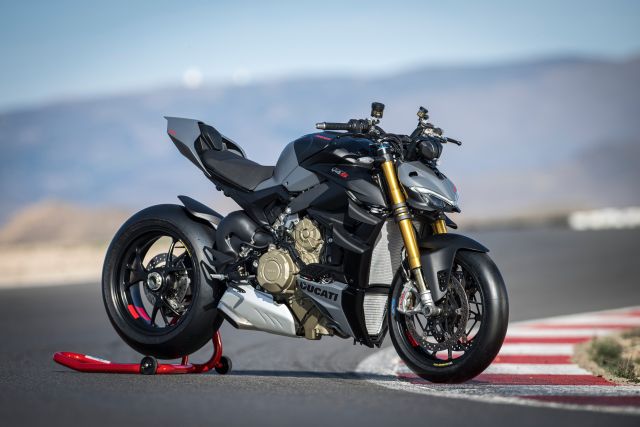
Story: Adam Child ‘Chad’
Photography: Alex Photo
To test the new 2023 updates, we headed to Andalucía in Spain, a demanding and tricky track to see if we could feel the differences and experience one of the most demanding naked bikes in the market. Is the new 2023 Streetfighter worth the extra money?
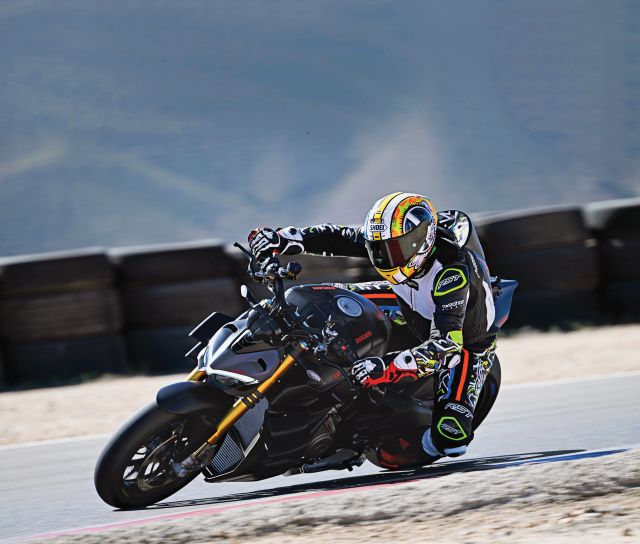
Raising the swing-arm pivot to reduce squat (up by four millimetres) and moving weight forwards means Ducati have tweaked the S model’s Öhlins NIX30 forks to create a sportier and firmer feel, more like the Panigale’s, but with the same spring as the previous Streetfighter. The sophisticated rider aids have also been re-calibrated. The suspension remains Öhlins Smart EC 2.0 semi-active, spring preload is manually adjustable as before. Weight is down a fraction due to the lithium-ion battery, 1.7 kilograms, but the alloy front frame and dimensions remain the same.
The new 2023 Streetfighter is certainly sporty, sportier than the previous model, but it is difficult to say by how much. In testing, Ducati test riders were one second faster on the new model compared to the older and fractionally heavier bike.

The standard settings in Sport mode are impressive, with the bike relatively soft on track and easy to live with and clearly made for a brisk road ride. Up the tempo to the sharp end of the fast group, though, and it becomes apparent that you need to opt for Race mode. In Race mode, the power, torque, and throttle remain the same but the semi-active suspension makes a dramatic shift from road to track. The weight of the bike is more supported, the chassis feels livelier, easier to turn, and ground clearance is improved. Within half a lap you are carrying even more corner speed and confidence.
The feel from the adjustable lever and the bite from the Stylemas, which remain unchanged, makes for a sublime combination. Stability is excellent, stopping power is stupendous, and the new fuel-tank (one litre larger) allows you to stay seated in the saddle with less effort. The only weakness is human arm strength.
The brakes are backed up by excellent Cornering ABS EVO and the new Engine Brake Control EVO 2 which has three levels and now engine braking is controlled whilst monitoring lean angle, gear, and throttle. When you hit the brakes, there is very little traction on the rear; therefore, less engine braking; as you release the brake and approach the corner apex, there is more engine braking, depending on speed, gear, and lean angle.
Normally, when we attend a world press launch, especially a track-only event, we expect the manufacturer to have added a few more bhp or injected more torque. In this case, however, the power and torque curves remain the same as the previous model and, to be honest, I am not complaining. Ducati’s hugely powerful Streetfighter V4 S could even have been tamed a little had a few horses been shaved from its brutally potent motor and I would have been happy.
Describing the Streetfighter as “powerful” or “fast” is like describing Mike Tyson as a level-headed sort of chap who would rather debate things out than get punchy. Every time you ride the V4 on track, you know you are in for a serious workout.
I spent the first two sessions of this test using the Sport mode: short-shifting on the new super-smooth up-and-down quick-shifter, trying to re-familiarise with the tricky Andalucía racetrack. However, despite not pushing for a fast lap and being a few thousand revolutions per minute (rpm) short of the red-line in each gear, the V4 felt utterly up for the fight. Ferociously strong.
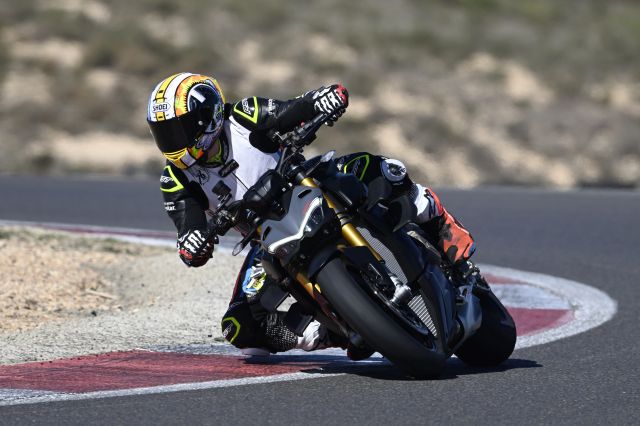
Session three and it was time to start pushing for a fast lap in Race mode. Race mode displays the Panigale dash, which clearly highlights the active rider aids in colour down the right side, plus a big gear position indicator, huge rev-counter and (addictive and optional) GPS lap-timer. Race and Sport modes have the same peak power and torque figures, with torque limited in the lower gears, but the Öhlins semi-active suspension delivers a tauter ride in Sport.
With the race dash active, it is impossible not to chase a lap-time and all-too tempting to treat every lap like Superpole, especially as every facet of the Streetfighter makes it feel and behave like an unfaired race bike.
It loves to rev and makes power all the way to the red-line. On Andalucía’s back straight it was still accelerating hard in fifth gear at 250 km/h. Every time I opened the throttle, it tried to separate my arms from their sockets as I was shoved back on to the seat’s bum-stop. Meanwhile, those rider aids are illuminating the dash as the updated electronics busily and brilliantly suppress wheelies or send the traction control into overtime (despite running soft Pirelli slicks in perfect conditions).
For session four, I bravely selected the new full-power engine mode (“Full”), which sits outside the riding mode options and has to be selected manually. And the only thing it does is limit the V4’s torque fractionally in first gear, every other gear is full fat.
Until that point, I thought the Streetfighter was desperately quick, like few other bikes that I have ridden over 25 years of testing and racing, but this is another step. As I have found with Ducati’s Panigale V4, which I have ridden several times on track, an unrestrained, unleashed Stradale V4 is almost too much. It gives both the rider and rider aids an intense examination and an even tougher workout that demands everything from you in terms of commitment and concentration.
Selecting Full is undeniably one of the most exciting things you can do on a motorcycle and some riders may prefer it to the more managed engine strategies (High, Medium, and Low) when chasing that compelling lap-timer. But if I were to ride on track all day, I would favour the limited torque strategies, which give both the rider and outstanding electronics an easier time. For normal humans that also translates into a more enjoyable and satisfying ride.
It is worth mentioning the rider aids, which are predictably excellent. As mentioned, the track dash display gives live readouts of rider aid intervention, clearly showing in full colour which ones you are using. Once back in the pits, you can scroll through your lap data, scrutinise lap-times, discover your maximum lean and revs, top speed, and even your maximum yaw, which is the measurement of the slide.
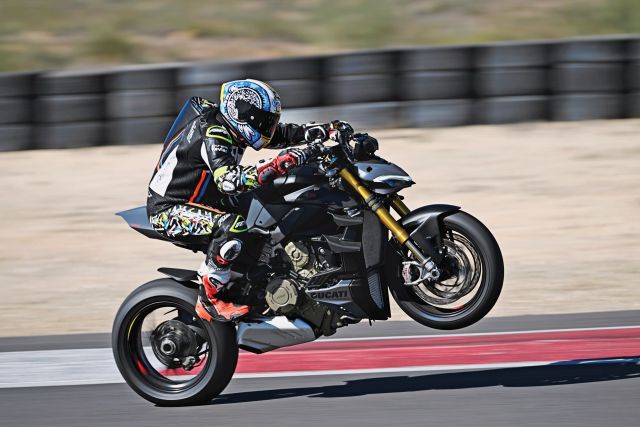
Just to see and for fun, I removed the Ducati Wheelie Control (DWC) and the Streetfighter raised its lightweight three-spoke alloy front wheel in first, second, and third gears on a mere whiff of throttle over crests. It is far easier and faster to lap with DWC active. Same story for the Ducati Traction Control (DTC) and Ducati Slide Control (DSC). I did reduce the latter’s intervention from standard but again went a fraction slower. The rider aids and new track dash make it all so easy, help turn the Streetfighter into supremely quick and fluent track device beyond the dreams of track-day regulars of just a couple of years ago. I hate to lean on a cliché but it really does go like a real-life video game—chasing lap-times, trimming the rider aids to suit, and watching the lap-times fall.
The Italians have not just produced a naked superbike; they have also looked at its road use and, dare I say, practicality. Fuel-tank capacity goes up by one litre to 17 litres, which should make for a slightly longer range. Incidentally and almost obviously, the quoted fuel economy stays the same at 13.1 km/l.
This was a track-only test of the new V4 S; therefore, we could not test fuel range, but the new fuel-tank certainly provides more support on track and should do the same on the road.
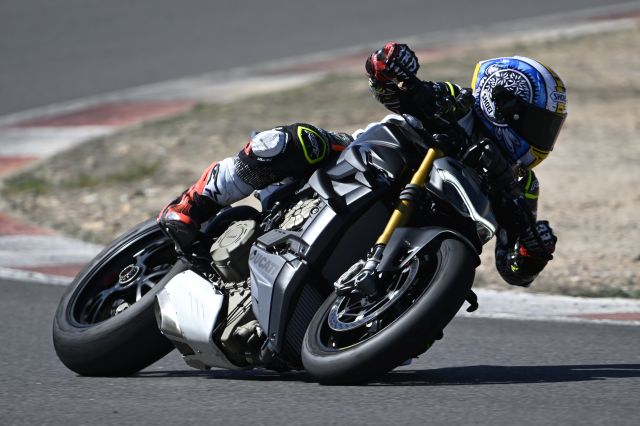
There is a new “Wet” riding mode that limits power to a mere 165 hp, while throttle response and rider aids also get re-configured accordingly. As is often the case, this wet weather mode might also be useful as a town mode or to save fuel.
Road, previously known as “Street” mode, limits torque in the first four gears (Race and Sport limit torque in the first three gears and have their own level of rider aid intervention).
The new quick-shifter is similar to that on the Panigale and is smoother and faster than before and should prove beneficial on the road.
Ducati have not made huge changes with the new 2023 Streetfighter V4 S, because they did not need to. Power and torque are the same, the motorcycle is still blisteringly quick and, excitingly, almost too much in a naked chassis.
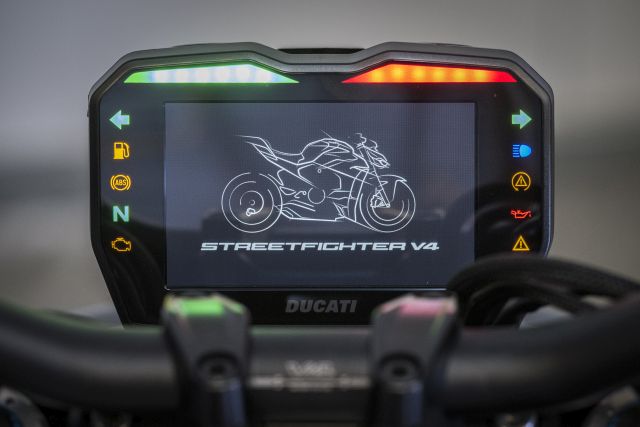
However, they have tweaked the final set-up, which is sportier than before. The new Panigale dash is not just functional and visually appealing; it also helps turn the Streetfighter into a track-day tool that is even more refined and responsive—and easier to ride at a good pace. You really do trim your rider aids as you chase a lap-time; it really does feel like a video game.
Ducati have not just made the Streetfighter closer to a naked race bike either. A new wet-weather mode, a larger 17-litre fuel-tank, and a super smooth quick-shifter will only make the V4 more capable and fun to ride on the road. And we cannot ignore the revised styling either, or the oh-so-apparent appeal and exclusivity the bike exudes.
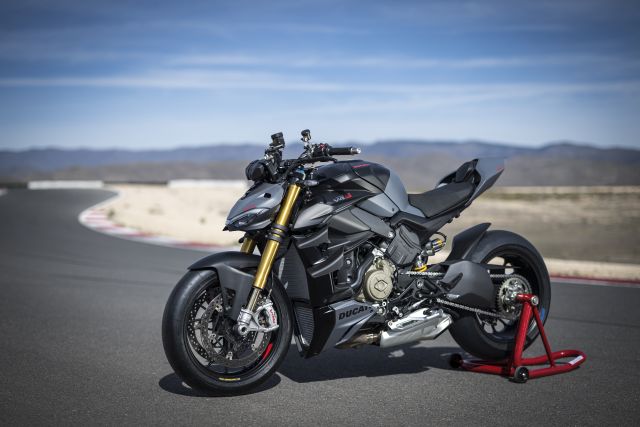
The only downside is price: £21,095 (Rs 21.10 lakh) for the base model and £22,895 (Rs 22.90 lakh) for the S means ownership requires serious money. But if you want one of the craziest (apart from the exclusive SP2 ’Fighter) naked bikes available in the market and one that can embarrass superbikes one minute and commute to work the next, you probably expect to have to dig deep.
Specifications
Ducati Streetfighter V4 S
ENGINE
Capacity 1,103 cc
Type Water-cooled, V4
Bore and stroke 81 x 53.5 mm
Compression ratio 14.0:1
Valvetrain 16-valve, desmodromic
Electronic fuel injection Ride by wire
Transmission Six-speed with quick-shifter
Clutch Hydraulically controlled slipper and self-servo wet multi-plate
Final drive Chain
PERFORMANCE
Power 208 hp at 13,000 rpm
Torque 123 Nm at 9,500 rpm
Top speed 260 km/h (estimated)
Fuel consumption 13.1 km/l (claimed)
ELECTRONICS
Riding Modes, Power Modes, Cornering ABS EVO, Ducati Traction Control (DTC) EVO 2, Ducati Wheelie Control (DWC) EVO, Ducati Slide Control (DSC), Engine Brake Control (EBC) EVO 2, Auto tyre calibration, Ducati Power Launch (DPL), Ducati Quick Shift (DQS) up/down EVO 2
CHASSIS
Frame Alloy front frame
Rake/Trail 24.5°/100 mm
Wheelbase 1,488 mm
SUSPENSION
Type Öhlins semi-active
Front 43-mm USD, fully adjustable, 120-mm travel
Rear Monoshock fully adjustable, 130-mm travel
WHEELS AND BRAKES
Front wheel 3.50 x 17-inch, alloy, Marchesini
Rear wheel 6.00 x 17-inch, alloy, Marchesini
TyresFront 120/70 ZR17, Pirelli Diablo Rosso IV Corsa
Rear 200/60 ZR17, Pirelli Diablo Rosso IV Corsa
Brakes Brembo, Cornering ABS EVO
Front: Twin 330-mm disc, four-piston Brembo Stylema calipers
Rear: 245-mm disc, two-piston caliper
DIMENSIONS
Weight 178 kg (dry), 197.5 kg (kerb)
Seat height 845 mm
Fuel capacity 18 litres
Servicing 12,000 km/12 months. Valve check 24,000 km
Warranty Two years
Website www.Ducati.com

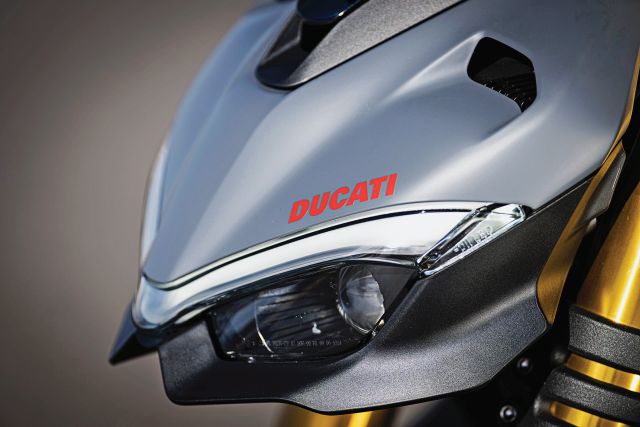
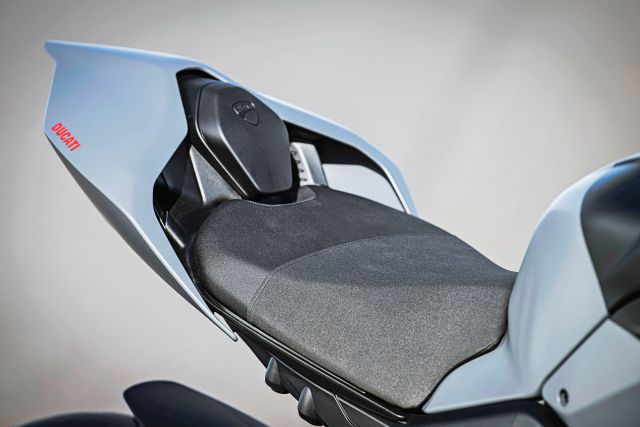
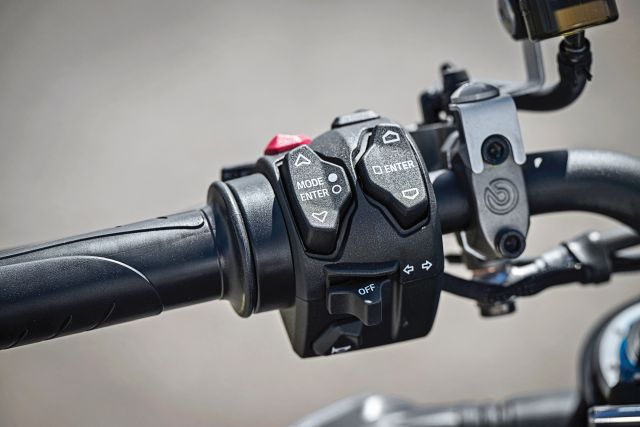
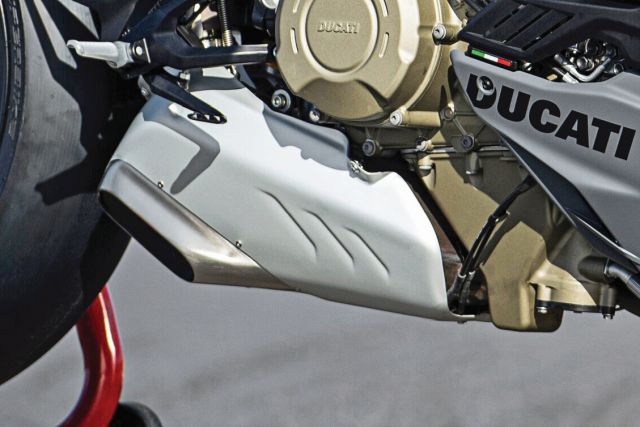

Leave a Reply